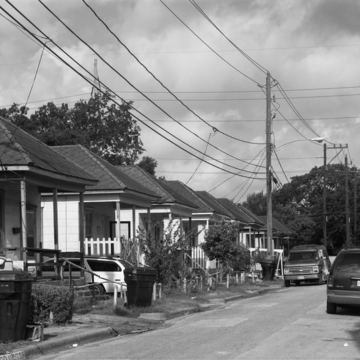This block front of ten identical shotgun cottages, built at intervals over an eight-year period, has survived one of the most profound cultural tragedies to afflict Houston in the 1990s, the destruction of Fourth Ward, Houston's most historic African American neighborhood. One of the distinctive qualities of the ninety-block neighborhood was the rich diversity of its vernacular architecture. The shotgun cottage, a house type that began to be built in Houston in the 1880s, was the architectural symbol of Fourth Ward. The unusually narrow streets of Fourth Ward and the closely packed wood cottages along them preserved traditional lifeways that Fourth Ward residents performed in the shadows of the skyscrapers of central Houston. By the early twenty-first century, these shotgun cottages on Victor Street, identical despite their construction over a span of years, were rare survivors among proliferating town house complexes and bulky lofts.
You are here
Shotgun Cottages
If SAH Archipedia has been useful to you, please consider supporting it.
SAH Archipedia tells the story of the United States through its buildings, landscapes, and cities. This freely available resource empowers the public with authoritative knowledge that deepens their understanding and appreciation of the built environment. But the Society of Architectural Historians, which created SAH Archipedia with University of Virginia Press, needs your support to maintain the high-caliber research, writing, photography, cartography, editing, design, and programming that make SAH Archipedia a trusted online resource available to all who value the history of place, heritage tourism, and learning.





















